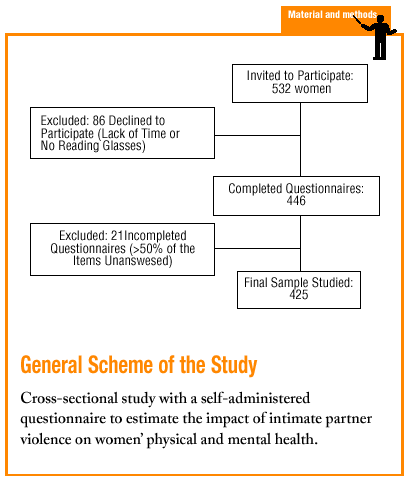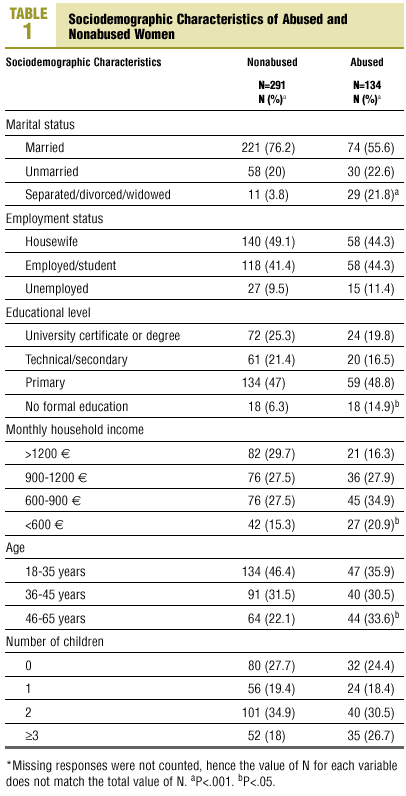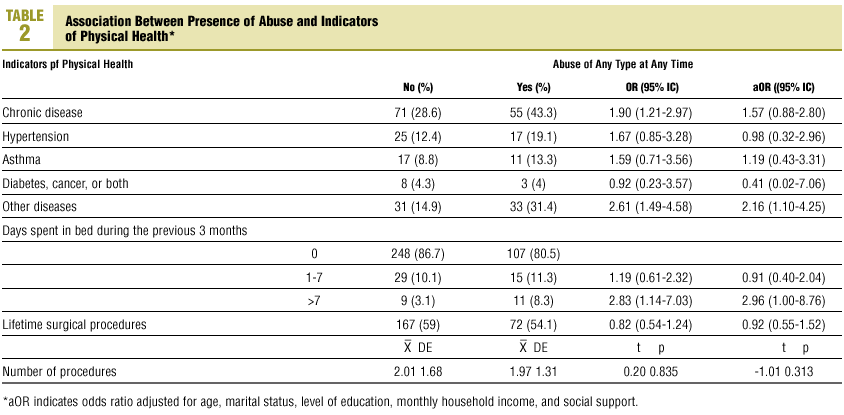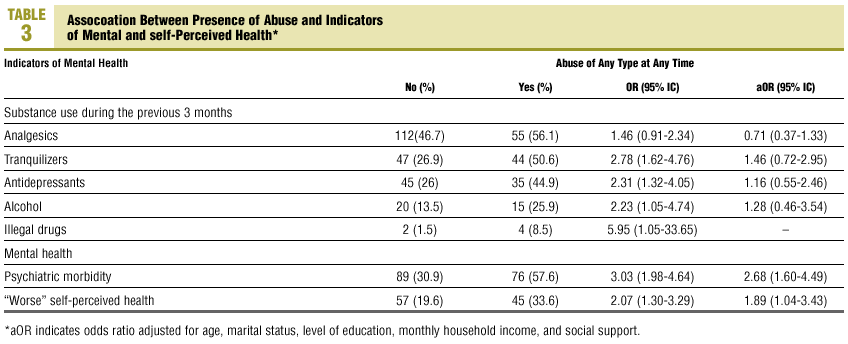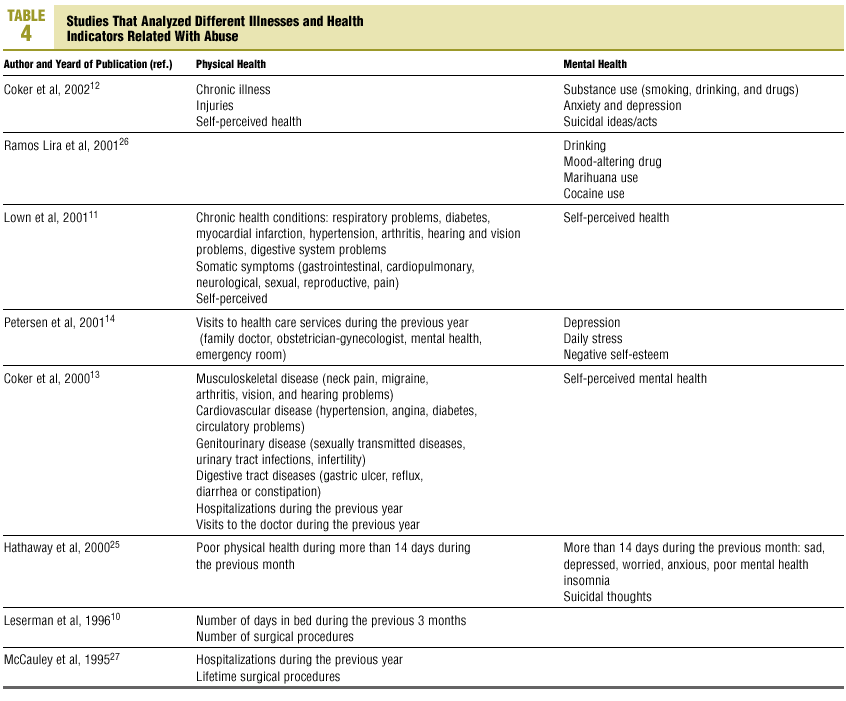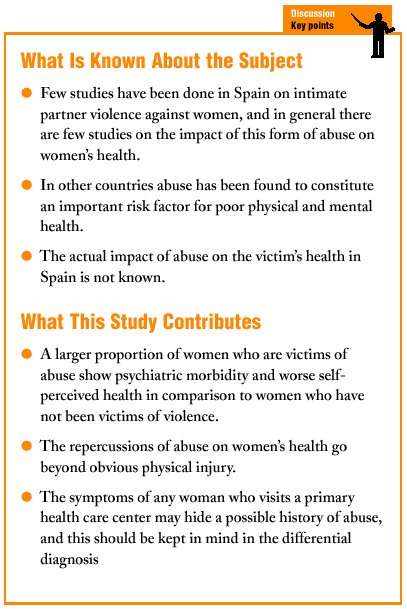Introduction
Domestic violence is defined as physical, sexual, and psychological violence against women in the family milieu by a person who is or was her intimate partner.1 Information regarding the prevalence of abuse usually cited in Spain is provided by the Ministry of Domestic Affairs (Ministerio del Interior), and refers to the number of reports of domestic violence to the police. In the year 2002 a total of 43 313 such reports were filed. With regard to mortality, the most recent figures show that in 2002, 52 women died as a consequence of physical abuse. At the time of writing, 61 women had died during 2003 from physical abuse.2
Most studies have concentrated on the prevalence of domestic violence and the usefulness of screening instruments. However, recent interest has centered on ways to evaluate the impact of abuse on women's health. Although it is clear that any type of assault or violence involves negative consequences for the victim, the extent of these consequences is greatly amplified when abuse occurs within the milieu of an intimate relationship, given that such abuse is chronic, and given that the context, in principle, should represent a source of intimacy and security for women.3
Biomedical models usually consider violence as a health problem per se, and often classify injuries as self-inflicted. However, in addition to health problems, intimate partner violence is also a risk factor for poor health. Abuse can lead to a variety of short- and long-term illnesses and to both physical and mental health problems.4-6
The most direct and visible effects of violence are physical injury, but episodes of abuse often recur over a period of time.7 It is only recently that the long-term impact on women´s health has begun to be investigated. The physical health problems reported to date include functional physical limitations, greater numbers of diagnostic tests and surgical procedures, and more days spent in bed, as well a greater frequency of health service usage.8-10 In addition, intimate partner abuse has been associated with an increased risk of developing chronic diseases such as hypertension, diabetes, chronic pain, gastrointestinal disorders, somatic problems and fibromyalgia.11-13
Regarding the impact on mental health, it is now believed that abuse increases the frequency of a number of symptoms and clinical conditions ranging from anxiety, insomnia and low self-esteem to clinical depression or posttraumatic stress disorder.3 Violence also harms health by increasing negative behaviors such as smoking, drinking and drug use, high-risk sexual behaviors and physical inactivity.7,14
Earlier studies have also shown that the proportion of victims of abuse who report poorer health is larger than the proportion of women who have not suffered intimate partner violence.13 Self-perceived health status reflects how a person perceives his or her own physical and psychological health, and has been found to be a good predictor of other more objective indicators such as life expectancy, mortality, chronic diseases and use of health services.
The only published study to examine the frequency of domestic violence in Spain is the large survey carried out by the Instituto de la Mujer (Institute of Women's Affairs) in 1999, which placed the percentage of women technically considered to be victims of abuse at 12.4%. In addition to looking at the prevalence of abuse, this survey inquired about a number of physical and psychiatric symptoms, and found that all were more frequent among abused than among nonabused women.15
The present study was designed to investigate the impact of domestic violence on physical and mental health in women seen at primary care centers in three provinces in Andalusia, southern Spain.
Material and Methods
Subjects
Participants in this cross-sectional study were women between 18 and 65 years old who were seen at 6 primary care centers in the Autonomous Community of Andalusia (southern Spain)
between May and July 2003. The centers were chosen because of their easy access. We excluded women who had not had an intimate partner at any time during their life, who were unable to read or write, non-Spanish women who did not understand Spanish, and women with severe cognitive impairment. In accordance with the Ethical and Safety Recommendations for Research on Domestic Violence Against Women,16 we also excluded women who came to the center with their husband or partner.
For an expected frequency of illness in abused women of 50%, a statistical power of 80% and a 95% confidence level, a minimum of 306 participants were needed to detect a minimum odds ratio (OR)=2.
At least 2 women per day were included from each health center, depending on the circumstances, and a total of 532 women were contacted. Participants were selected with the same randomized procedure at all centers. If a woman we contacted did not fulfill the inclusion criteria, the next woman to enter the center was contacted for possible inclusion.
Variables and Instruments
A structured, self-administered questionnaire designed specifically for this study was used to collect information. The questionnaire consisted of 21 closed items, and the time needed to complete it was about 10 minutes. The variables investigated in this study are described below.
Sociodemographic variables: age (quantitative), marital status (married, unmarried, separated or divorced, widow), employment status (housewife, employed outside the home, student, unemployed), educational level (no formal education, primary school, technical school, secondary school, 2- or 3- year university certificate, university degree), monthly household income (<600 e, 600-900 e, 900-1200 e, >1200 e), and number of children (quantitative).
Variables related with abuse: presence of different types of abuse (physical [slap or punch, kick, push, etc], psychological [threats, insults, humiliating remarks, abnormal jealousy, fear, etc], or sexual) with the woman's current partner or a previous partner. Each of these 6 questions had three possible responses: "Many times", "Sometimes" or "Never." The woman was considered to be a victim of abuse if she answered "Many times" or "Sometimes" to any of the 6 items on abuse.
Items relating to abuse were taken from a questionnaire used in an earlier survey; this instrument was shown to be easy to use and understand, and to be readily accepted by respondents.17 The items were designed on the basis of scales used in earlier studies, including the WHO Multi-Country Study on Women's Health and Domestic Violence Against Women.18-20
Physical health indicators: the presence of chronic illness (yes/no) was recorded with the item "Do you have, or have you ever had, any chronic illnesses?" The possible responses were "hypertension," "diabetes," "asthma," "cancer," and "other." Information was also requested about the number of surgical procedures during the woman's lifetime, and about the number of days spent in bed during the previous 3 months.
These 3 indicators of physical health were chosen as the most appropriate for a self-administered questionnaire requiring little time to complete.
Mental health indicators: the questionnaire sought information about the presence of psychiatric morbidity (yes/no), which was recorded with the Goldberg General Health Questionnaire (GHQ-12). This instrument has been adapted and validated for the Spanish population and is used widely to measure psychiatric morbidity in nonpsychiatric care settings. Closed items were used to obtain information regarding the use during the previous 3 months of tranquilizers, antidepressants, analgesics, alcohol, and illegal drugs.
Self-perceived health: one item solicited information on self-perceived health: "How would you describe your current state of health compared to one year ago?" The possible responses were "Better," "The same," or "Worse."
Social support: a single yes/no item gave participants the opportunity to indicate the presence or absence of social support.
The dependent variables in this study were indicators of physical health, indicators of psychiatric health, and self-perceived health. The independent variables were presence of abuse, sociodemographic variables, and social support.
Procedure
Information was recorded in the waiting room after the woman had been seen by the doctor or while she was waiting to be seen. The questionnaires were given to the women by the physician in the examining room or at the end of the visit, or by other participating health center staff members in the waiting room. After the woman's participation was requested and after fulfillment of the inclusion criteria was verified, each woman was given a brief description of the study to explain that its purpose was to investigate women's health. The questionnaire was given to each woman in an open envelope. The envelope contained pamphlets with information about the resources available in the woman's health care district, associations for abused women, and the telephone numbers of different services that provide aid to abused women.
It was emphasized that all responses would remain confidential and anonymous. The women were urged to complete all items of the questionnaire and to ask any questions they might have about the study. After the woman had completed the questionnaire, she sealed it in the envelope and placed the envelope in a collection box set up at each health center.
Statistical Analysis
The SPSS (v. 11) was used for all statistical analyses.
Descriptive statistics were generated first. For quantitative variables we used numeric summaries (mean, median, standard deviation, minimum, and maximum) and graphic displays (bar charts and histograms), and for qualitative variables we used frequency tables (number and percentage of cases) and graphic displays (pie charts).
The relationship between qualitative dependent variables and each of the independent variables was analyzed with chi-squared (*2) tests (for qualitative independent variables) and Student's t test or analysis of variance (ANOVA) (for quantitative independent variables). The strength of association was estimated as the crude odds ratio (cOR) with 95% confidence intervals. The relationship between quantitative dependent variables and qualitative independent variables was analyzed with Student's t test or ANOVA.
The relationship between each health variable and the presence of abuse was estimated with logistic regression models adjusted for sociodemographic characteristics and the presence of social support. When the dependent variable was a continuous variable, linear regression analysis was used.
Results
During the study period 532 women seen at 6 participating health centers were approached and invited to take part in the study. Of this number, 86 declined to participate (most because of lack of time or because they had not brought their reading glasses with them). A total of 446 completed questionnaires were returned, 21 of which were excluded because of incomplete data (>50% of the items left unanswered). The final sample consisted of 425 women, for a response rate of 79.88%.
Analysis of the sociodemographic characteristics showed the most frequent age group to be women 18 to 35 years old (42.6%). One third (33.6%) of the women had 2 children. Most women were married (69.4%) and nearly half (46.6%) were housewives. Nearly half of the participants (45.4%) had received primary school education only. The proportion of women who reported a monthly household income less than 600 e was 16.2%.
The results for physical health indicators showed that one third of the women (33.6%) reported at least one chronic illness. The most frequent, mentioned by 14.4% of the women, was hypertension, followed by asthma (10.1%), and "other" (20.4%). Diabetes, cancer, or both, were mentioned by 4.2%. Slightly more than half (57.5%) responded that they had undergone at least one surgical procedure during their lifetime, and the mean number of lifetime surgical procedures was 2. Time spent in bed during the previous 3 months was more than 7 days in 4.7% of the women, and the mean time was 1.4 days.
Psychiatric morbidity was reported by 39.3% of the women. About half (49.4%) had used analgesics, 34.7% had taken tranquilizers, 31.9% had used antidepressants, 17% reporting using alcohol, and 3.4% noted illegal drug use. A slight majority of the respondents (56.5%) considered their health status to be the same as one year previously, whereas 24% felt it was worse, and 19.5% felt it was better.
Almost one third of the women (31.5%) reported physical, mental or sexual abuse by a current or previous partner. Abuse was described as occurring "many times" in 10.1% of the cases.
Sociodemographic differences between women who had and had not been abused at any time during their life are summarized in Table 1. In comparison to nonabused women, women who reported suffering abuse were more frequently separated, divorced or widowed (P<.001), had more frequently received no formal education (P<.05), more frequently reported a monthly household income of less than 900 e (P<.05), and tended to be older than 46 years (P<.05).
Relationship Between Physical Health Indicators and Presence of Abuse
Table 2 shows the frequencies and crude associations between each physical health indicator and the presence of abuse, and the association after adjustment for age, marital status, level of education, household income and social support.
Women who had been victims of abuse were at a higher risk of chronic illness, although the differences were not statistically significant. According to type of disease or illness, only the category "other diseases" showed a statistically significant association with abuse (aOR=2.16; 95% CI, 1.10-4.25). The association between abuse and having spent more than 7 days in bed during the previous 3 months was also statistically significant (aOR=2.96; 95% CI, 1.00-8.76).
Relationship Between Mental Health Indicators, Self-Perceived Health and Presence of Abuse
Table 3 shows the frequency and crude association for each mental health indicator and for self-perceived health with the presence of abuse, and the association after adjusting for age, marital status, level of education, household income, and social support. Abuse was significantly associated with psychiatric morbidity (aOR=26.8; 95% CI, 1.60-4.49) and with poorer self-perceived health (aOR=1.89; 95% CI, 1.04-3.43) after adjustment for each of the variables listed above.
Certain substances were used more frequently by abused women than by nonabused women, e.g., analgesics (56.1% vs 46.7%), tranquilizers (50.6% vs 26.9%), antidepressants (44.9% vs 26%), alcohol (25.9% vs 13.5%), and illegal drugs (8.5% vs 1.5%). Although the association between abuse and substance use was significant for all substances except analgesics, the differences were no longer significant after adjustment for age, marital status, level of education, household income, and social support.
Discussion
We should first note some potential limitations to the present study. The most important limitations are related with our exclusion criteria.
We excluded women who were accompanied by their partner. Although the frequency of abuse may have been highest among these women, the Ethical and Safety Recommendations for Research on Domestic Violence Against Women advise against inclusion.16 Moreover, abuse has been associated with low sociocultural levels, but because of the methods used here we opted to exclude women who were unable to read. These criteria may have led us to underestimate the actual frequency of abuse.
Given the subjective nature of the responses in our self-administered questionnaire, information bias may have been introduced because of reluctance on the part of some women to cooperate fully, because some may have provided responses they considered socially acceptable, or because some of the questions may have been misunderstood. The cross-sectional study design makes it difficult to infer causality or a mechanism of association that might link abuse to the health problems we identified. A further limitation which should be kept in mind for future studies is the lack of information on a possible childhood history of physical or sexual abuse--a potential confounding factor in studies of health problems.21
In this study of women who visited primary health care centers, the global frequency of abuse was 31.5%. This figure is consistent with the findings of other studies performed in health care settings, particularly in English-speaking countries, where the reported prevalence of abuse ranged from 20% to 55%.22,23
The sociodemographic characteristics found to be significantly more frequent among women who suffered abuse were older age, low level of education, low household income, and being separated, divorced or widowed. These characteristics, as in studies done in other countries,3,13 are evidence of the unsatisfactory economic situation these women may find themselves in. This situation, together with difficulties in finding employment, may force women to remain dependent on their partner and may thus prevent them from starting a new life on their own. Because of the cross-sectional design used in the present study, we were unable to establish a relationship between being separated or divorced and the greater frequency of abuse, since separation or divorce can in themselves be a consequence of abuse.
Table 4 lists the different types of diseases and health indicators that earlier studies have examined. Most of these studies found a positive association between abuse and physical health problems. Abused women in the present study more frequently reported chronic diseases and had spent more days in bed during the previous 3 months. These results are consistent with the findings of studies that used indicators similar to the ones we investigated.10,12 For example, a population-based study in the USA found that women who had been victims of physical abuse were 1.6 times as likely to develop chronic diseases as women who had not suffered any type of abuse.12 Likewise, a study of patients seen in a gastroenterology practice found that abused women spent more days in bed and had undergone more surgical procedures than nonabused women.10
In studies that investigated mental health, there was greater consistency in terms of the diseases and indicators used to investigate the impact of intimate partner abuse (Table 4). The results of the present study show that in global terms, abuse is associated with poorer mental health and a greater frequency of substance use. However, after adjustment for potential confounders, the association between substance use and partner abuse was no longer significant. It should none the less be borne in mind that the lack of a significant association might have been the result of the small sample size, which may have reduced the power of our analysis. Abuse was also associated significantly with worse self-perceived health, a finding consistent with the results of earlier studies.13,24 In a population-based study in the USA, women who were victims of abuse showed more depression and anxiety than nonabused women.25 A Mexican study also found significant differences in the use of mood-altering drugs (antidepressants, amphetamines, tranquilizers, and stimulants) among women who were victims of domestic violence and nonvictims.26 These results suggest the hypothesis that abused women may try to soothe their reactions to trauma by consuming excessive amounts of substances such as mood-altering drugs, alcohol, or illegal drugs.
A significantly larger proportion of abused than nonabused women in the present study reported feeling in worse general health than one year previously, a finding also noted in earlier studies.13,24
To conclude, our results should serve as a warning and wake-up call to health care professionals, who should realize that domestic violence is a frequent problem in their practices. Family physicians should recall at all times that physical injuries are not the only "proof" of domestic violence, but are only the tip of the iceberg. Practically all women contact primary care services at some time during their life, and this means that the primary care setting can play an essential role in helping women who are victims of intimate partner abuse. For this to happen, however, all professionals should become aware of the facts pertaining to the impact of partner violence on women's health, and should learn to detect the signs of partner violence against women. We recommend further research into the dimension of the problem in Spain, and into the ways in which different types of abuse influence the victim's health.





